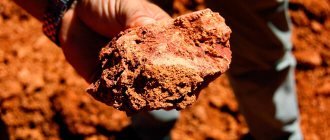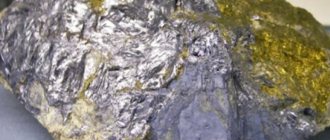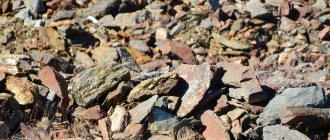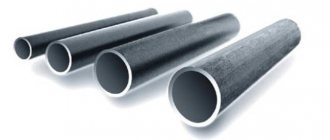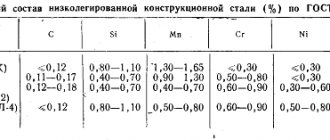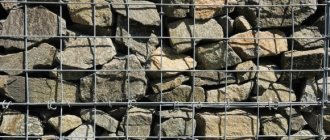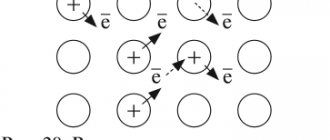Rare metal ores are geological rocks containing rare metals (a group of 60 elements rarely found in nature) in pure form or as admixtures of other chemical elements. Moreover, the concentration of metals in ores must be such that the development of deposits is profitable.
- Preparatory process
- Radioelectronics
Types and characteristics
Rare metals themselves are divided into five large groups:
- Lungs: beryllium, lithium, rubidium, strontium, cesium.
- Radioactive: actinium, radium, thorium, uranium and transuranic elements.
- Scattered metals: gallium, hafnium, germanium, indium, rhenium, selenium, thallium, tellurium.
- Rare earths: yttrium, lanthanum and lanthanides, scandium.
- Refractory metals: vanadium, tungsten, molybdenum, niobium, tantalum, zirconium.
This division is very conditional, since with the improvement of geological exploration and the development of industry, some metals are leaving the category of rare elements. The very concept of “rarity” indicates their insignificant use. However, new advanced technologies are radically changing the situation.
Sources of rare metals can be deposits, highly mineralized waters, brine of salt lakes, placers, as well as by-products or waste from main industries. Rare metal ores can be divided into those directly rich in rare elements, and ores of other elements in which rare minerals are present as impurities. Among the complex ores we can distinguish:
- tungsten-molybdenum,
- titanium-niobium-tantalum-rare earth,
- uranium-vanadium,
- lithium-cesium,
- zirconium-niobium.
Examples of rare metal ores themselves are:
- Lithium ores are spodumene, amblygonite, lepidolite, zinnwaldite, petalite.
- Beryllium ores – beryl, bertrandite, phenacite.
- Titanium ores – ilmenite, rutile, ilmenorutile, perovskite, sphene.
- Zirconium ores – baddelite, zircon.
How the situation on the metallurgical market is developing
Speaking about a specific enterprise, we can come to the conclusion that not all of them remain eternal giants. Since if the ore reserves in a certain place come to an end, then such a metal processing plant is closed, since it is no longer needed. The plant can also be repurposed for another type of activity.
Much is connected with the market situation; the volume of production of metal products also depends on what the demand is in the market. This also affects how much it costs to process metal and produce new products. Considering that the amount of metal consumed is growing, as new mines are being found in other countries, therefore, for example, I was forced to reduce the cost of gold, which is necessary to extract it from deposits. But the stability in the international market remains stable for now. The mentioned plant is ready to expand its enterprise. Because they want to use laser equipment.
Speaking about gold mining, I would like to say that in Russia it has increased significantly. Most of it can be obtained in the Krasnoyarsk Territory and the Kemerovo region. Moreover, such metal is used not only as a result of its extraction, but also in the processing of scrap, waste parts, and purification from impurities of other metals.
To summarize, I would like to say that metal is a good help in the modern world, since almost everything is made from it. This means that its production will be relevant for many years to come.
Extraction methods
Open
Since significant reserves of rare metals are concentrated in the earth’s crust, subject to weathering and placers, the most common method of their extraction is the open-pit method. To develop placer deposits, a dredge is often used - a floating mining and processing complex.
In the case of quarry deposits, a complex of geological exploration, stripping, excavation and transport work is carried out, followed by enrichment. Naturally, this is associated with high costs and harmful effects on the environment.
Closed
The mine mining method does not lose its position in the list of methods for extracting such minerals as rare metal ores. It is usually used when there is a need to remove expensive rocks from the bowels of the earth, located at depths of up to half a kilometer or more.
Otherwise, production will be unprofitable, since it will not cover the costs of constructing a mine and operating expensive equipment.
How is ore mined?
In order to make metal, a variety of ores are required. There are many types of them underground. For example, we can talk about:
- Copper-nickel,
- Zhelezny,
- Lead-zinc and others.
In addition, each ore contains impurities, for example, iron. Not only iron is extracted from it, but also other metals, since there are many impurities of other metals there.
As we already understood, metal is extracted from ore, so several methods must be used for the extraction process. We can talk about two such methods: firstly, open or quarry and, secondly, underground or mine. There is also a combined method, that is, open-underground. As for the first type of ore mining, it is carried out directly in the open air on the surface. To do this, you must first prepare everything you need to get the rock. During this process, first of all, the earth mass is separated from the extracted rock, then the rock is loosened to extract the ore, separating it from everything else. Extraction from rocks is possible, in this case drilling and blasting is used.
In order to blow up a rock, they take granulite, granulated ammonium nitrate granulite and water-filled explosives. Having extracted the ore, everything is loaded into transport using a lifting and transport mechanism. Then the unnecessary soil is taken to the fields where it is cultivated.
As for underground work, the upper part of the earth is not touched. You can build on it and plant fields. But they drip deep underground. Although the open-pit method is very popular, the lion's share of minerals is mined underground. To do this, the deposit must first be opened, then removed; this process is similar to the open method. Then comes the cleaning work, it consists in removing the raw materials using the bulk method, this can also be done separately, that is, selective excavation is used. This is how iron ore and other minerals can be extracted from the ground.
Heavy equipment is used to extract ore, but this is not all in the modern world, since to detect deposits they use computer technology, which allows them to detect, plan, and design future work.
Enrichment technology
The raw materials from which rare metals and elements are extracted usually contain tenths or even thousandths of a percent of the necessary materials.
Preparatory process
Crushing and grinding separate mined minerals from waste rock. The result is a product in a form acceptable for further processing with a given concentration of the mined metal.
In case of difficulties with enrichment (uranium ores or a number of other minerals), hydrometallurgical methods for extracting metals are used. For a number of valuable large-size fraction minerals, manual mining of ore on a conveyor is used.
Main process
The main beneficiation process consists of mechanical, physical and chemical processes, the purpose of which is to obtain concentrate (a product of ore enrichment that has a high concentration of the required mineral) and waste.
In the case of processing rare metal ores, the following types of enrichment are used:
- Crushing followed by screening is based on the different degrees of hardness of useful and waste rocks.
- Sliding of the necessary minerals along an inclined plane at a speed different from unused materials.
- Gravity enrichment - the operating principle of this method is based on different speeds of falling mineral grains in a gaseous or liquid medium.
- Flotation enrichment, which is based on a change in surface wettability under the influence of flotation reagents.
- Magnetic enrichment separates materials based on their magnetic properties.
- Electrostatic beneficiation is based on the use of differences in the electrical properties of minerals.
Helper process
Technological processes that facilitate the main processing processes are called “auxiliary”.
It is not possible to obtain rare metals directly from ores. The output of a number of complex basic processing processes are only oxides and salts. Naturally, end consumers are not satisfied with this, since they require highly purified metals.
To solve this problem, enrichment methods are used, the essence of which is: decomposition, creating compounds of the required purity, obtaining technically pure metal or alloys with its presence in their composition, refining the metal, obtaining ingots or products with the simultaneous formation of the desired physical and chemical structure. These methods are based on hydrometallurgical, chemical and pyrometallurgical processes.
Chemical composition
The properties of iron ore, its value and characteristics directly depend on its chemical composition. Iron ore may contain varying amounts of iron and other impurities. Depending on this, there are several types:
- very rich, when the iron content in the ores exceeds 65%;
- rich, the percentage of iron in which varies from 60% to 65%;
- average, from 45% and above;
- poor, in which the percentage of useful elements does not exceed 45%.
The more by-products there are in iron ore, the more energy is needed to process it, and the less efficient the production of finished products is.
The composition of a rock can be a combination of various minerals, waste rock and other by-products, the ratio of which depends on its deposit.
Chemical composition of iron ores
Composition of iron ores of large deposits
Gap rock may also contain iron, but recycling it is not economically feasible. The most commonly found minerals are iron oxides, carbonates and silicates.
It should be noted that ferruginous rocks may contain a huge amount of harmful substances, among which are sulfur, arsenic, phosphorus and others.
Scope of application
The production and consumption of rare metals and elements is growing every year. The most promising branches of science and technology are in particular need of them.
Radioelectronics
The very basis of semiconductor devices is made up of such chemical elements as gallium, germanium, indium, selenium, and tellurium. There are about two dozen rare earth metals in modern mobile devices. The monitor displays on every desktop contain europium, yttrium, and terbium. Superconducting materials have been created based on niobium. The creation of a modern electron tube is impossible without beryllium, tungsten, molybdenum, zirconium and thorium.
Instrumentation
Rare metals are widely used in instrument making. These are, first of all, rubidium and cesium - the most popular materials in the production of solar cells. In addition, heavy-duty magnets, electric vacuum equipment, fluorescent lamps, and solar panels are made from rare metals. Many modern technical means contain precious materials: platinum, gold, silver, iridium, palladium, rhodium. Radioactive metals are widely used in the manufacture of instruments for scientific research and medicine.
Nuclear technology
The use of the phenomenon of radioactivity at one time served as the basis for the creation of nuclear energy. The reactors of modern nuclear power plants, icebreakers, and nuclear submarines run on uranium. In addition, the following are widely used in nuclear technology: beryllium, zirconium, hafnium, niobium, tantalum, vanadium and lithium. And this is far from the limit. Modern research into thermonuclear reactions, and in the future the creation of new nuclear installations in a wide variety of industries, will require an increasing use of rare minerals and elements.
Mechanical engineering
Modern mechanical engineering has in its arsenal more than 60 metals and thousands of alloys. A significant part of them are rare metals. Very often they act as important additives in alloys. It is thanks to such additives that high-strength compounds are created that are resistant to high temperatures, chemical and mechanical stress, and corrosion.
The scope of application of rare metals in mechanical engineering is comprehensive. They are found everywhere: from nanotechnology to the manufacture of spacecraft and giant ships.
Chemical industry
The chemical industry is unthinkable without the use of rare metals and their compounds. They are everywhere: in technological equipment, among control and measuring instruments, and directly in the chemical processes themselves. With the help of rare metal catalysts, today we produce sugar, alcohol, oxalic acid, and produce various types of fuels and technological raw materials.
Metallurgy
It is metallurgy that serves as the main conductor of rare metals to all sectors of the world economy. After all, it is only thanks to the metallurgical processes themselves that finished products of these chemical elements are obtained. But that's not all. These minerals also play an important role in the production of ferrous and non-ferrous metallurgy, allowing the production of metals and alloys with predetermined properties.
Non-ferrous metals
Non-ferrous metals are important for industry . Many of them geochemically belong to the group of chalcophiles, related to copper (chalcos - copper): copper, lead, zinc, molybdenum, bismuth. In nature, these metals form compounds with sulfur, sulfides.
Minerals of non-ferrous metals were deposited mostly from hot aqueous solutions; the main ones for copper are chalcopyrite - a golden mineral, bornite - a purple mineral, a constant companion of chalcopyrite, as well as black sooty chalcocite, which is found in the upper part of many copper deposits.
Copper ores
Copper deposits are very diverse. In recent years, low-grade disseminated ores of the so-called porphyry type, which often occur in volcanic vents, have become very important. They were formed from hot solutions coming from deep magma chambers. The reserves of such ores are huge, especially in South and North America.
of copper ores formed during volcanic eruptions at the bottom of the seas
are also of great importance This is the so-called pyrite type, in which copper pyrite - chalcopyrite - is found together with iron pyrite - pyrite.
These deposits have long served as the main source of ores in the Urals. Finally, the role of the so-called cuprous sandstones, containing copper minerals, is important. This type includes deposits in the Chita region, and abroad the largest deposits of Katanga in Africa.
Deposits in Russia and the world
Rare metal deposits are diverse in nature and are found in many countries around the world. Thus, coarse-crystalline rocks - pegmatites, rich in beryl, lithium and tantalum, cesium and rubidium occur in the territories of the following deposits:
- Bernick Lake - Canada.
- Bikita - Zimbabwe.
- Caribbean - Namibia.
- Greenbushes - Australia.
- Koktogay - China.
Tantalite minerals accumulated in placers are still mined semi-manually on the African continent: in Burundi, Congo, Nigeria and Rwanda.
Carbonatites, products of crystallization of deep layers, which became the main sources of niobium and rare earth raw materials, were discovered and developed in Brazil (Arasha) and in the United States (Mountain Pass). Later they were joined by: Saint-Honoré in Canada, Tomtorskoye field in Yakutia (Russia), Seis-Logos in Brazil.
The richest carbonatite deposits have also been explored in China (Bayun-Obo) and Australia (Mount Weld). The latter is characterized by the highest concentration of minerals.
On the territory of Russia there is a fairly large deposit of loparite on the Kola Peninsula. There are also deposits of rare-metal alkaline granites in the Katuginsky (Tuva) and Uluk-Tanzeksky (Chita region) deposits.
In general, it can be stated that the number of world deposits (the number of which is constantly growing) of rare metals is quite capable of meeting their needs for many centuries to come.
Extraction[edit]
Some ore deposits in the world
Some additional ore deposits in the world
Main article: mining
Basic mining of ore deposits consists of the following stages:
- Searching or prospecting to find and then determine the grade and value of ore where it is found (an "ore body").
- Conduct a resource assessment to mathematically estimate the size and level of the deposit.
- Conduct a preliminary feasibility study to determine the theoretical economics of the ore deposit. This allows you to determine early on whether further investment in assessment and engineering studies is warranted, and to identify key risks and areas for further work.
- Conduct a feasibility study to assess the financial viability, technical and financial risks and sustainability of the project and decide whether the proposed mine project should be developed or abandoned. This includes mine planning to assess the economically recoverable portion of the deposit, metallurgy and ore recoverability, marketability and solvency of ore concentrates, engineering, milling and infrastructure costs, financial and equity requirements, and a cradle-to-grave analysis of a potential mine from initial excavation before reclamation.
- Development to provide access to the ore body and the building of a mine workshop and equipment.
- Mine work in the active sense.
- Reclamation to create land at the site of a mine suitable for future use.
